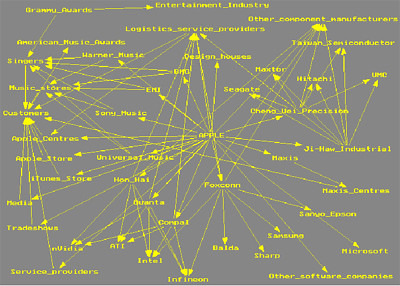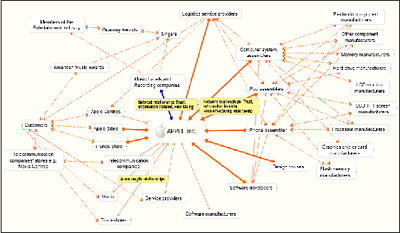. . . Continued from Part 1
3.0 Network Perspective
3.1 General
Network perspective is concerned with the understanding of the complex relationships between organisations or companies over a period of time to develop and attain competitive advantage.
In the analysis of Apple’s business network, we can identify that Apple possesses three subgroups or network clusters i.e. the cluster for the Mac personal computer line of business, iPod line of business, and iPhone line of business. Each of the network clusters exhibit its own level of embeddedness. For e.g., in the iPod line of business network cluster, Apple’s first relationship tie or link is to Cheng Uei Precision, whom Apple had thoroughly evaluated and appointed to manufacture/assemble the iPod. With the increasing iPod demand over time, Apple appointed Ji-Haw Industrial as the second manufacturer/assembler (New iPod Maker, 2004).
In turn, Cheng Uei Precision and Ji-Haw Industrial have their respective subgroup network relationships albeit they may also share common parts or component suppliers, for e.g. Seagate, a hard disk drive manufacturer. This network embeddedness is shown in Figure 3-1.
However, for e.g., the network embeddedness does not stop at Seagate, as Seagate will also possess its own subgroup network; and a company known as Komag – one of several manufacturers in the world of the magnetic discs used in hard disk drive manufacturing – would likely be present in Seagate’s subgroup network.
Figure 3-1: Apple’s Network Embeddedness

Furthermore, each tie of link in Apple’s network may exhibit a similar or variant relationship. Figure 3-2 shows Apple’s network relationships. Relationship lines drawn in thick orange colour represents strong network relationships between Apple and the partners. Thin orange relationship lines indicate an arm’s length relationship between Apple and the partners, and the dotted orange relationship lines represent the relationships between Apple’s partners, or second level relationships.
Of significance is a blue coloured thick relationship line between Apple and the music labels and recording companies, such as BMG , EMI, Sony Music, Universal Music, and Warner Music. The relationship is unique and was critical to Apple achieving a competitive advantage because Apple was the only company licensed by the music labels and recording companies to sell digital music encrypted in the Advanced Audio Coding (AAC ) format with Digital Rights Management (DRM) technology to prevent or minimize music piracy. Non-iPod users i.e. Mac personal computer users will require a free iTunes application to download and playback the AAC -DRM encrypted (or protected AAC ) digital music on their Macs. The DRM restrictions on digital music files were removed from January 2009 onwards after Apple reached an agreement with the major record labels.
The digital music is sold online by Apple on its iTunes music store http://www.apple.com/itunes/. The iTunes music store began life in 2003 with an initial 200,000 music files available for download, and prices then was USD0.99 cents per song. Today, typical prices are USD0.69, 0.99 and 1.29 per song. Apple rebranded the iTunes music store to iTunes media store since it now also offers movies, audiobooks, iPod games, Podcasts, etc. Since late 2006, the iTunes media store “accounts for 85 percent of the songs downloaded in the U.S.
3.2.1 Tie Modality
Is concerned about the network from the following aspects:
a) Strength of the Connection
Apple’s network comprises of strong network relationships and arm’s length relationships. Apple’s relationships with its manufacturers/assemblers, design houses, software developers, Apple and iTunes online stores are strong network relationships where the following interaction elements take place:
§ Trust – critical to establish strong embedded ties where the connected parties will not act to each other’s self-interest at the expense of the other
§ Fine-grained information transfer – is implicit and holistic in nature where important product and trade secrets are shared between the parties for critical mutual benefits
§ Joint problem-solving activities – the parties work closely to resolve operational, product and technological challenges, again for their critical mutual benefits
§ Risk taking and investment – with the above elements of trust, fine-grained information sharing and joint problem-solving relationship, the parties concerned are able and willing to take necessary business risks and investment needs within the network
§ Complex or adaptation – with all the above interaction elements, the parties in the network are able to adapt to new market challenges and opportunities
b) Intent of the Connection
This is concerned with the parties of the network coming together for exploration or exploitation objectives.
In the case of Apple, the network it builds with its key partners, for e.g. the manufacturers/assemblers of its iPods, has an exploitation intention where Apple can leverage on the manufacturing and assembling expertise and infrastructure of companies like Cheng Uei Precision and Ji-Haw Industrial, without the need for high capital investments for manufacturing and assembly plants and facilities.
Similarly, Cheng Uei Precision and Ji-Haw Industrial are also exploiting Apple in the sense that by producing high demand Apple products such as the iPod, the business opportunity adds significantly to their company revenues and profitability, respectively.
In other relationships between Apple and its design house partners, the intent takes on an exploration relationship where both parties explore product, design and functionality innovations.
Outside of the United States
c) Nature of the Connection
Nature of the connection questions the cooperation or competition aspects of the relationship. For e.g., Apple can promote competition between its iPod manufacturer/assembler to attain a higher level of production quality and cost efficiency improvements in production methodologies i.e. operational management concepts such as zero defect and Lean Six Sigma best practices.
Among its distributor and dealer channels, Apple can leverage competition to outperform each other in sales and customer support quality. However, Apple will need to exercise proper judgment in promoting competition among its network subgroups or clusters in order to continue maintaining the network equilibrium to optimize mutual benefits.
To this aspect, most of the relationship ties or links are cooperative in nature, so that Apple and its partners leverage on each others’ strengths and balance out weaknesses.
d) Stability of the Network
In Apple’s network, our analysis has shown that there are strong network relationships and arm’s length relationships. Both forms of relationships add to the stability and dynamism of Apple’s network.
In other words, the strong network relationships between Apple and its partners creates stability in the network, while the arm’s length relationships between Apple and other categories of partners which can be changed or replaced from time-to-time, such as distributors and dealers, creates the dynamism of the network.
3.2.2 Network Position
Apple’s position in the network can be considered from:
a) Characteristics of the Position, deals with:
§ The role of the firm over other firms
§ Identity of other firms (direct or indirect)
§ Importance of the firm
§ Strength of relationship
b) Power
§ Differences in power results in different network positions
§ The ability to influence the decisions or actions of others
§ Relationships are asymmetrical with respect to power
§ Power structures dictate the way the network operates and develops
c) Positional advantage
§ Particular positions in the network can serve as a source of competitive advantage
§ Competitive advantage can only be achieved if a particular firm has at least 3 relationships with 3 other firms, and the position held is not too strong
Thus, Apple gains positional advantage from having strong network relationships from:
o Specially selected partners that contribute different or complimentary functionalities and expertise
o The music labels and recording companies providing Apple with exclusive distribution rights to AAC -DRM encoded digital music titles
o Software developers which Apple collaborates with in developing ease-of-use and advanced technology firmware and operating systems
o Apple is able to hold centre-court within its network, deciding on final product and service offerings, and business terms & conditions
o Collaboration and inputs from its Level 2 network partners enable Apple to explore new ideas and technology via its Level 1 network partners
3.2.3 Legitimacy
Apple gains legitimacy through its network performance from the following key areas:
a) Economic
This concerns the economic returns or the creation of shareholder value through revenue generation and profitability. As shown in Section 1.0 – Introduction, Apple’s financial or economic returns are very promising and profitable.
b) Legal
In the area of legality and as far as the iPod and the music industry is concerned, reducing and eradicating music piracy remains a challenge. With the iPod and iTunes media store, Apple has been championing the use of original songs vis-à-vis upholding the intellectual property rights of singers and related parties.
Apple only promotes the sale of AAC -DRM encrypted digital songs on its online iTunes media store instead of the generic MP3 digital audio format. Only from January 2009 onwards, Apple removed the DRM restrictions after having secured the agreements of the major records labels. Thus, the initial AAC-DRM only music files gave Apple a market edge in gaining the confidence of the major record labels.
Furthermore, the AAC encoding technology has been standardized by the International Organisation for Standardization (ISO) and the International Electrotechnical Commission (IEC) as part of MPEG2 and MPEG4 standards (Herre & Dietz, 2008, pp. 137 – 142; Dimkovic, 2001, pp. 1 – 7).
c) Ethical
Apple practices and consistently champions the:
§ Use of legally obtained songs and downloads
§ Use of original software among its customers
§ Sales of original software by its distributor and dealer channels
3.2.4 Structural Hole
A structural hole (Burt, 1995) exists between the traditional music industry (using analog playback equipment, audio cassettes and CDs) and digital technology.
Apple was able to identify this structural hole and the opportunity it presented, and bridged the chasm with innovation on the consumer-side with the introduction of a highly portable, high audio reproduction quality, and cool-looking digital device called the Apple iPod, packaged with supporting services such as the availability of original digital songs at very affordable prices, and a cyberspace platform that provided 24x7 access to buy the digital songs.
For the traditional music industry plague with music piracy, declining sales, and changing consumer trends brought about by the Internet and digital technology, the new revenue channel opportunity presented by Apple was too good to ignore.
3.2.5 Network Effects
The Apple network has resulted in the following effects (some examples):
§ Created an unprecedented economic boom in the way people acquire, listen and manage their music libraries i.e. the iPod Generation
§ Apple has sold over 160 million units of iPods for the period 2001 to 2008 (Boffey, 2008)
§ The 100 millionth iPod was shipped in April 2007 (Cohen, 2007)
§ In the fiscal year 2006, Apple shipped 5.3 million units of Macs, but 39 million units of iPods (Michaels & Moren, 2006)
§ As of late 2006, the iTunes media store accounts for 85% of the songs downloaded in the United States
§ Apple reported a record profit for fiscal Q1 2009 (Dalrymple, Seff & Michaels, 2009)
As networks are heterogeneous, thus, the difficulty of duplicating the uniqueness of Apple’s network relationships, interactions, and advantages creates a competitive advantage for Apple Inc.
Continued in Part 3 . . .

1 comment:
Hi Andrew - excellent paper. Is it possible to obtain clearer copies of the network diagrams, Fig 3.1 and 3.2?
Thanks
Adrian
Post a Comment